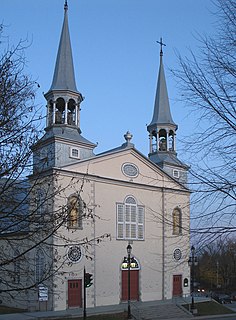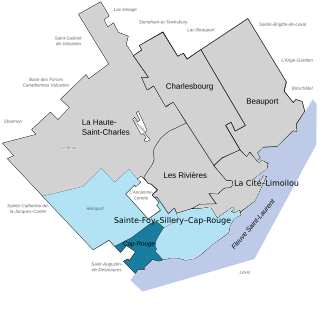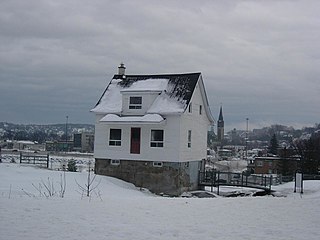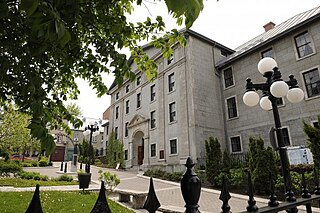
The Gulf of Saint Lawrence is the outlet of the North American Great Lakes via the Saint Lawrence River into the Atlantic Ocean. The gulf is a semi-enclosed sea, covering an area of about 226,000 square kilometres (87,000 sq mi) and containing about 34,500 cubic kilometres (8,300 cu mi) of water, which results in an average depth of 152 metres (499 ft).

The Canadian Centre for Architecture is a museum of architecture and research centre in Montreal, Quebec, Canada. It is located at 1920 Baile Street, between Fort Street and Saint-Marc Street in what was once part of the Golden Square Mile. Today, it is considered to be located in the Shaughnessy Village neighbourhood of the borough of Ville-Marie.

Charlesbourg is a borough of Quebec City, in the northeastern part of the city, west of the borough of Beauport.

Cap-Rouge is a former city in central Quebec, Canada, since 2002 within the borough Sainte-Foy–Sillery–Cap-Rouge in Quebec City. The site of the first attempted permanent French settlement in North America, Charlesbourg-Royal, is located at the confluence of the Rivière du Cap Rouge and the Saint Lawrence River. Its population was 13,153 as of the Canada 2011 Census.

The Saguenay flood was a series of flash floods on July 19 and 20, 1996 that hit the Saguenay-Lac-Saint-Jean region of Quebec, Canada. It was the biggest overland flood in 20th-century Canadian history.
Quebec County was a federal electoral district in Quebec, Canada, that was represented in the House of Commons of Canada from 1867 to 1925.

Beauport is a borough of Quebec City, Quebec, Canada on the Saint Lawrence River.

The Parliament Building is an eight-floor building in Quebec City and home to the Parliament of Quebec, composed of the Lieutenant-Governor and the National Assembly. The building was designed by architect Eugène-Étienne Taché and was built from 1877 to 1886. With the frontal tower, the building stands at 52 metres or 171 feet in height. The building is located in Place de l'Assemblée nationale, atop Parliament Hill in the district of Vieux-Québec–Cap-Blanc–colline Parlementaire, just outside the walls of Old Quebec; this area is part of the borough of La Cité-Limoilou.

The Frank Slide was a massive rockslide that buried part of the mining town of Frank, North-West Territories, Canada, at 4:10 a.m. on April 29, 1903. Around 110 million tonnes of limestone rock slid down Turtle Mountain. Witnesses reported that within 100 seconds the rock reached up the opposing hills, obliterating the eastern edge of Frank, the Canadian Pacific Railway line and the coal mine. It was one of the largest landslides in Canadian history and remains the deadliest, as between 70 and 90 of the town's residents were killed, most of whom remain buried in the rubble. Multiple factors led to the slide: Turtle Mountain's formation left it in a constant state of instability. Coal mining operations may have weakened the mountain's internal structure, as did a wet winter and cold snap on the night of the disaster.

The 1950 Red River flood was a devastating flood that took place along the Red River in The Dakotas and Manitoba from April 15 to June 12, 1950. Damage was particularly severe in the city of Winnipeg and its environs, which were inundated on May 5, also known as Black Friday to some residents.

The Battlefields Park includes the Plains of Abraham with the nearby and smaller Des Braves park, both within the district of Montcalm in Quebec City, and forms one of the few Canadian national urban parks. Its significance lies in the Battle of the Plains of Abraham (1759) and the Battle of Sainte-Foy, fought six months later on today's Des Braves park.

The Morrin Centre is a cultural centre in Quebec City, Quebec, Canada. It is designed to educate the public about the historic contribution and present-day culture of local English-speakers. The centre contains the private English-language library of the Literary and Historical Society of Quebec, heritage spaces for events, and interpretation services.

The Musée de la civilisation à Québec is a museum located in Quebec City, Quebec, Canada. It is situated in the historic Old Quebec area near the Saint Lawrence River. It was designed by architect Moshe Safdie, and opened its doors to the public on 19 December 1988.

The New Brunswick Museum, located in Saint John, New Brunswick, is Canada's oldest continuing museum. The New Brunswick Museum was incorporated as the "Provincial Museum" in 1929 and received its current name in 1930, but its history goes back much further. Its lineage can be traced back another 88 years to 1842 and to the work of Dr. Abraham Gesner.

Trans-Canada Air Lines (TCA) Flight 831 was a flight from Montréal–Dorval International Airport to Toronto International Airport on November 29, 1963. The aircraft was a four-engine Douglas DC-8-54CF airliner, registered CF-TJN. About five minutes after takeoff in poor weather, the jet crashed about 20 miles (32 km) north of Montreal, near Ste-Thérèse-de-Blainville, Quebec, Canada, killing all 118 people on board: 111 passengers and 7 crew members. The crash was the deadliest in Canadian history at that time. It was also the deadliest crash of a DC-8 at the time, and, as of 2019, the sixth deadliest.

The Just for Laughs Museum was a Canadian museum that opened in 1993, dedicated to humour located in Montreal, Quebec. The museum closed in 2011. It had been visited by more than two million people since its opening.

The Old Quebec Funicular is a funicular railway in the Old Quebec neighbourhood of Quebec City, Quebec, Canada. It links the Haute-Ville to the Basse-Ville, which includes such sites as the colonial-era Notre Dame des Victoires church, the historic Petit Champlain district, the port, and the Musée de la civilisation. Climbing at a 45-degree angle, the railway covers a total distance of 64 metres (210 ft).
The Lévis Forts were a series of three forts located on the South Shore of the Saint Lawrence River in Lévis, Quebec, Canada. They were at shooting distance of one another which allowed the defense of a wide area without the cost of a continuous defensive wall. The first one was built (1865-1872) by the British Army and the other ones by private businesses (1865-1869). The costs were almost identical for all three, ranging from 57,600 to 59,762 pounds.

The Greater Sudbury Museums are a network of four small community history museums in Greater Sudbury, Ontario. Three of the four are located on heritage properties in different neighbourhoods within the city, and the fourth is located in a library facility.

The St-Hilaire train disaster occurred on June 29, 1864, near the present-day town of Mont-Saint-Hilaire, Quebec. The train, which was carrying many German and Polish immigrants, fell through an open swing bridge into the Richelieu River after the crew failed to obey a stop signal. Though uncertain, the widely accepted death toll is 99 people. The disaster remains the worst railway accident in Canadian history.





















